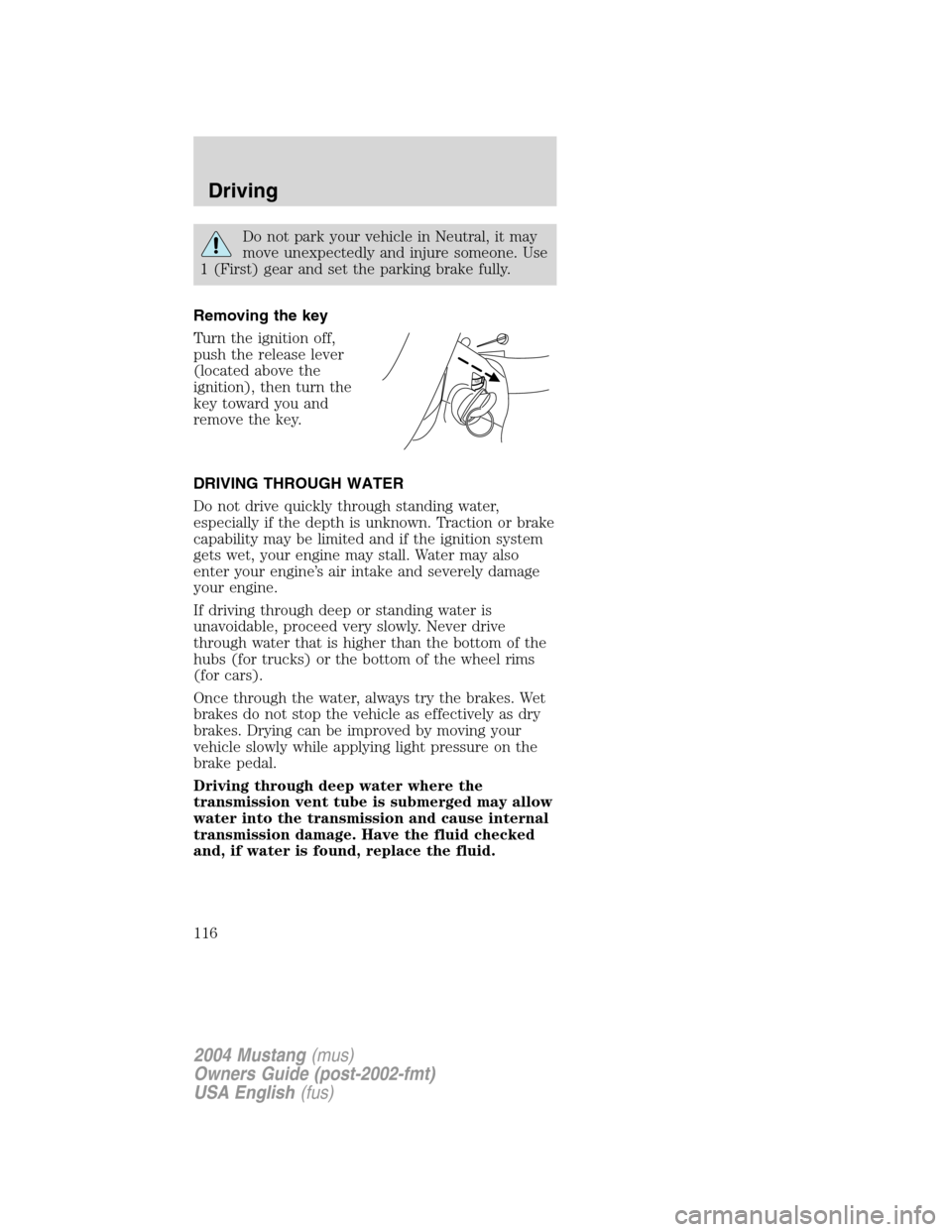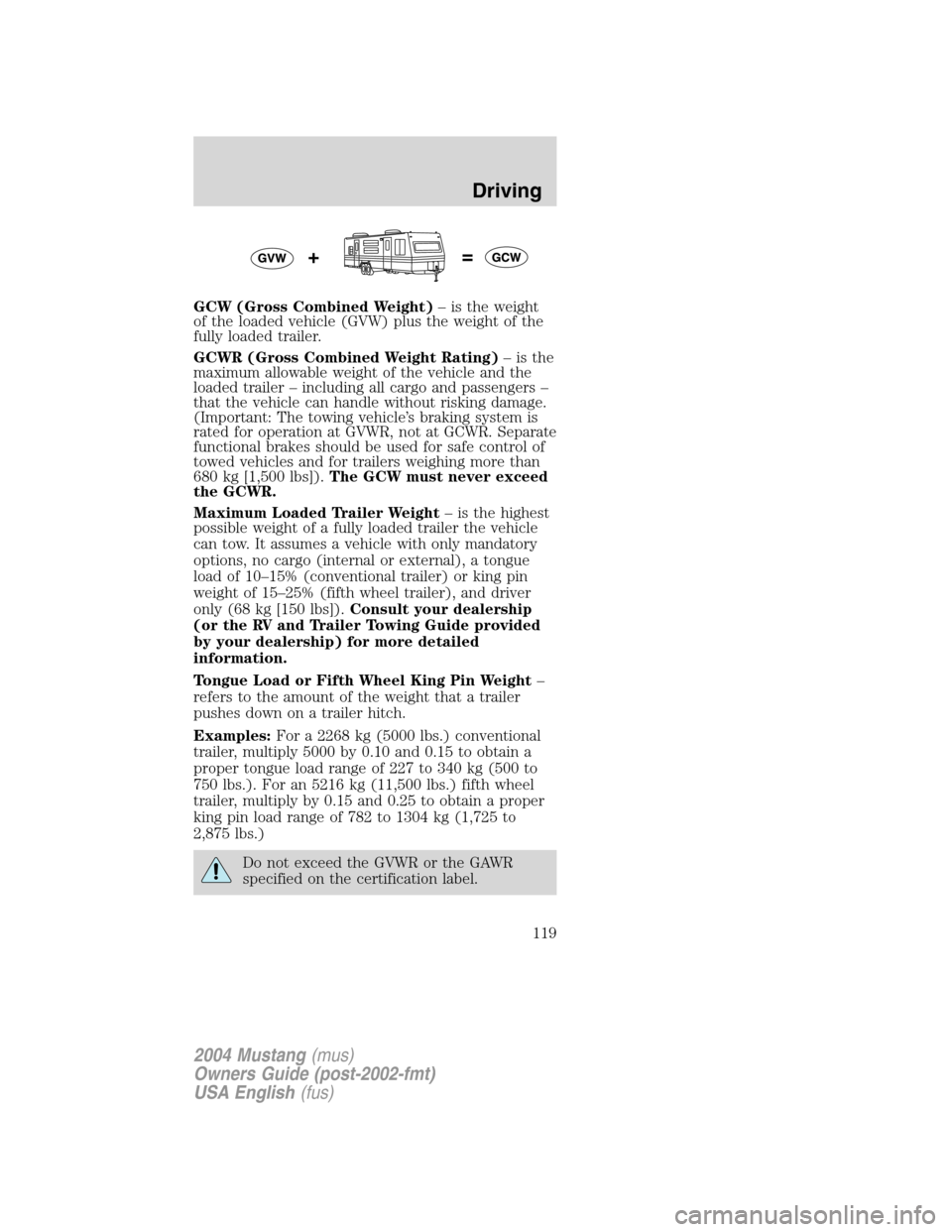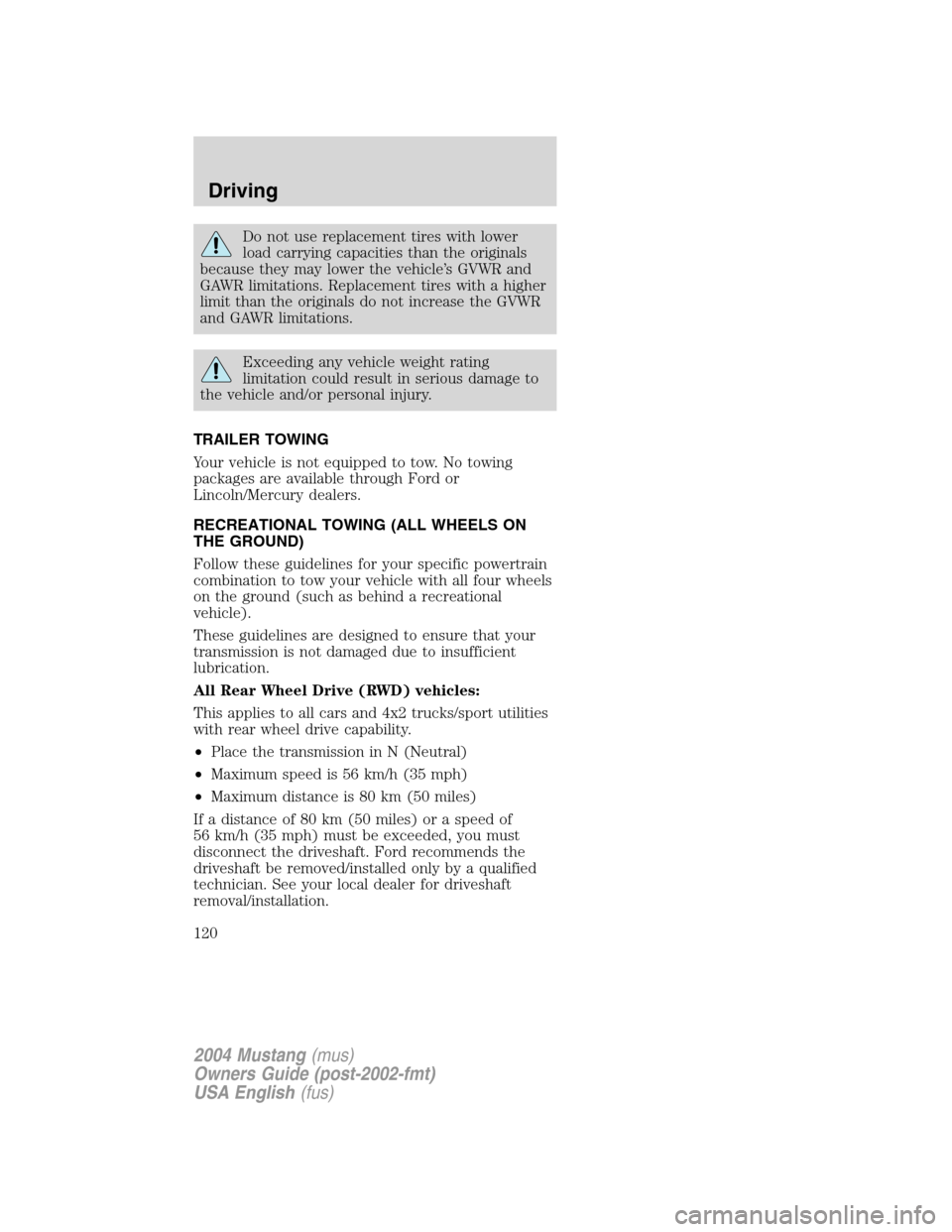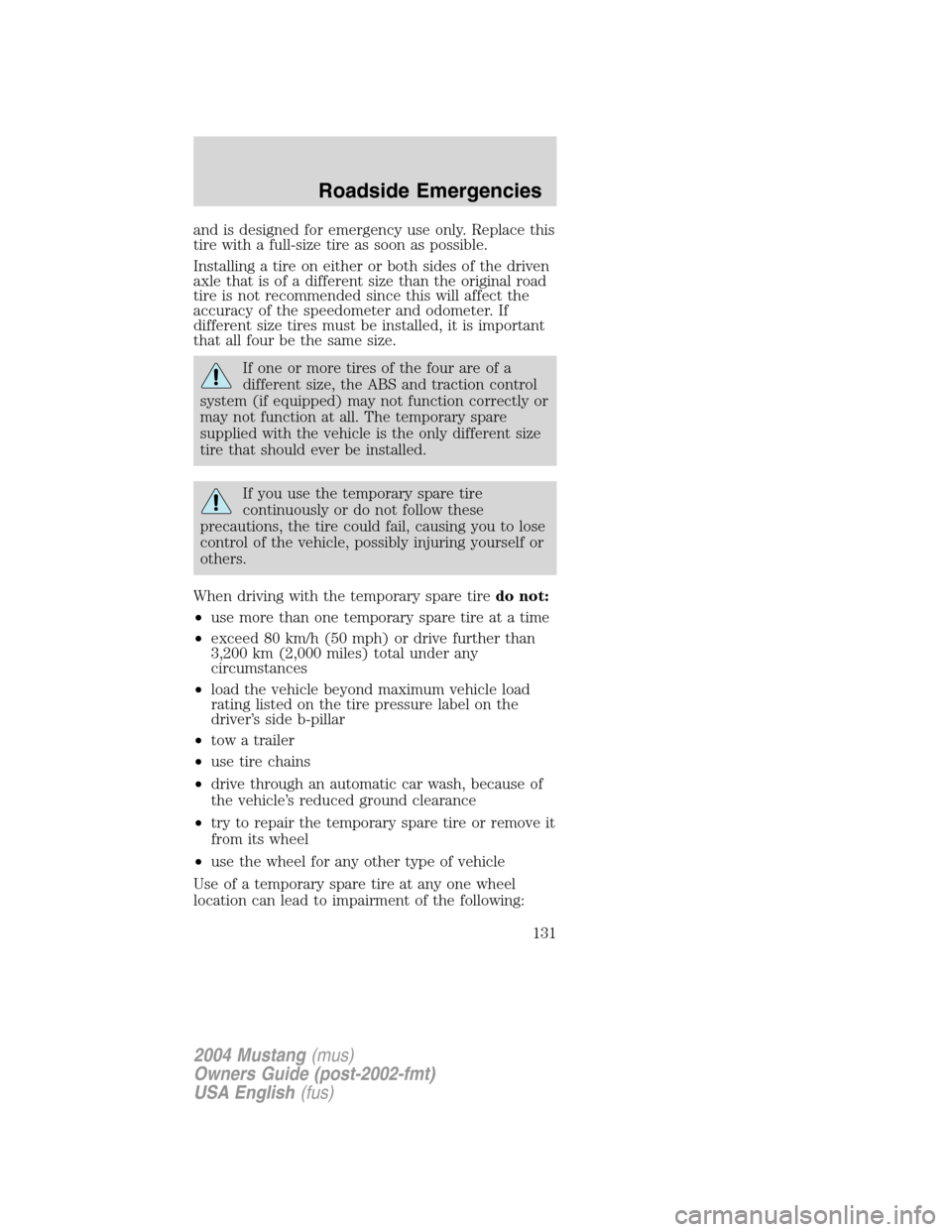Page 111 of 240
Understanding the gearshift positions of the
4–speed automatic transmission
P (Park)
This position locks the transmission and prevents
the rear wheels from turning.
To put your vehicle in gear:
•Start the engine
•Depress the brake pedal
•Move the gearshift lever into the desired gear
To put your vehicle in P (Park):
•Come to a complete stop
•Move the gearshift lever and securely latch it in P
(Park)
Always set the parking brake fully and make
sure the gearshift is latched in P (Park).
Turn the ignition to the LOCK position and remove
the key whenever you leave your vehicle.
2004 Mustang(mus)
Owners Guide (post-2002-fmt)
USA English(fus)
Driving
111
Page 116 of 240

Do not park your vehicle in Neutral, it may
move unexpectedly and injure someone. Use
1 (First) gear and set the parking brake fully.
Removing the key
Turn the ignition off,
push the release lever
(located above the
ignition), then turn the
key toward you and
remove the key.
DRIVING THROUGH WATER
Do not drive quickly through standing water,
especially if the depth is unknown. Traction or brake
capability may be limited and if the ignition system
gets wet, your engine may stall. Water may also
enter your engine’s air intake and severely damage
your engine.
If driving through deep or standing water is
unavoidable, proceed very slowly. Never drive
through water that is higher than the bottom of the
hubs (for trucks) or the bottom of the wheel rims
(for cars).
Once through the water, always try the brakes. Wet
brakes do not stop the vehicle as effectively as dry
brakes. Drying can be improved by moving your
vehicle slowly while applying light pressure on the
brake pedal.
Driving through deep water where the
transmission vent tube is submerged may allow
water into the transmission and cause internal
transmission damage. Have the fluid checked
and, if water is found, replace the fluid.
PUSH
2004 Mustang(mus)
Owners Guide (post-2002-fmt)
USA English(fus)
Driving
116
Page 119 of 240

GCW (Gross Combined Weight)–is the weight
of the loaded vehicle (GVW) plus the weight of the
fully loaded trailer.
GCWR (Gross Combined Weight Rating)–is the
maximum allowable weight of the vehicle and the
loaded trailer–including all cargo and passengers–
that the vehicle can handle without risking damage.
(Important: The towing vehicle’s braking system is
rated for operation at GVWR, not at GCWR. Separate
functional brakes should be used for safe control of
towed vehicles and for trailers weighing more than
680 kg [1,500 lbs]).The GCW must never exceed
the GCWR.
Maximum Loaded Trailer Weight–is the highest
possible weight of a fully loaded trailer the vehicle
can tow. It assumes a vehicle with only mandatory
options, no cargo (internal or external), a tongue
load of 10–15% (conventional trailer) or king pin
weight of 15–25% (fifth wheel trailer), and driver
only (68 kg [150 lbs]).Consult your dealership
(or the RV and Trailer Towing Guide provided
by your dealership) for more detailed
information.
Tongue Load or Fifth Wheel King Pin Weight–
refers to the amount of the weight that a trailer
pushes down on a trailer hitch.
Examples:For a 2268 kg (5000 lbs.) conventional
trailer, multiply 5000 by 0.10 and 0.15 to obtain a
proper tongue load range of 227 to 340 kg (500 to
750 lbs.). For an 5216 kg (11,500 lbs.) fifth wheel
trailer, multiply by 0.15 and 0.25 to obtain a proper
king pin load range of 782 to 1304 kg (1,725 to
2,875 lbs.)
Do not exceed the GVWR or the GAWR
specified on the certification label.
2004 Mustang(mus)
Owners Guide (post-2002-fmt)
USA English(fus)
Driving
119
Page 120 of 240

Do not use replacement tires with lower
load carrying capacities than the originals
because they may lower the vehicle’s GVWR and
GAWR limitations. Replacement tires with a higher
limit than the originals do not increase the GVWR
and GAWR limitations.
Exceeding any vehicle weight rating
limitation could result in serious damage to
the vehicle and/or personal injury.
TRAILER TOWING
Your vehicle is not equipped to tow. No towing
packages are available through Ford or
Lincoln/Mercury dealers.
RECREATIONAL TOWING (ALL WHEELS ON
THE GROUND)
Follow these guidelines for your specific powertrain
combination to tow your vehicle with all four wheels
on the ground (such as behind a recreational
vehicle).
These guidelines are designed to ensure that your
transmission is not damaged due to insufficient
lubrication.
All Rear Wheel Drive (RWD) vehicles:
This applies to all cars and 4x2 trucks/sport utilities
with rear wheel drive capability.
•Place the transmission in N (Neutral)
•Maximum speed is 56 km/h (35 mph)
•Maximum distance is 80 km (50 miles)
If a distance of 80 km (50 miles) or a speed of
56 km/h (35 mph) must be exceeded, you must
disconnect the driveshaft. Ford recommends the
driveshaft be removed/installed only by a qualified
technician. See your local dealer for driveshaft
removal/installation.
2004 Mustang(mus)
Owners Guide (post-2002-fmt)
USA English(fus)
Driving
120
Page 124 of 240

HAZARD FLASHER
The hazard flasher is
located on the steering
column, just behind the
steering wheel. The
hazard flashers will
operate when the
ignition is in any
position or if the key is
not in the ignition.
Push in the flasher control and all front and rear
direction signals will flash. Press the flasher control
again to turn them off. Use it when your vehicle is
disabled and is creating a safety hazard for other
motorists.
Note:With extended use, the flasher may run down
your battery.
FUEL PUMP SHUT-OFF SWITCH
FUEL
RESET
This device stops the electric fuel pump from
sending fuel to the engine when your vehicle has
had a substantial jolt.
After an accident, if the engine cranks but does not
start, this switch may have been activated.
The fuel pump shut-off
switch is located on
the left side of the
trunk between the left
rear tail light and the
trunk liner, and to the
left of the hole in the
trunk liner
To reset the switch:
1. Turn the ignition OFF.
2. Check the fuel system for leaks.
3. If no leaks are apparent, reset the switch by
pushing in on the reset button.
4. Turn the ignition ON.
2004 Mustang(mus)
Owners Guide (post-2002-fmt)
USA English(fus)
Roadside Emergencies
124
Page 126 of 240
Passenger compartment fuse panel
The fuse panel is located below and to the left of
the steering wheel by the brake pedal. Remove the
panel cover to access the fuses.
To remove a fuse use the fuse puller tool provided
on the fuse panel cover.
The fuses are coded as follows:
Fuse/Relay
LocationFuse Amp
RatingPassenger Compartment
Fuse Panel Description
1 20A Cigar lighter
2 20A Engine controls
3—Not used
4 10A Right-hand low beam
headlamp
5 15A Instrument cluster, Traction
control switch
6 20A Starter motor relay
7 15A GEM, Interior lamps
8 20A Engine controls
9 30A Mach 460 subwoofers
10 10A Left-hand low beam
headlamp
SEE OWNERS MANUAL FOR FUSE INFO
4212345
76891011
131214151617
191820212223
252426272829
313032333435
373638394041
43
44
2004 Mustang(mus)
Owners Guide (post-2002-fmt)
USA English(fus)
Roadside Emergencies
126
Page 130 of 240
Fuse/Relay
LocationFuse Amp
RatingPower Distribution Box
Description
13 30A* MACH 1000 left amplifiers
14 20A* Fuel pump
15 30A* MACH 1000 right amplifiers
16 20A* Horn
17 20A* ABS
18 30A* Power seats
19 10A* Intercooler pump (Cobra
only)
20 20A* Alternator
21—Not used
22—Not used
23—Not used
24 20A* A/C pressure
25—Not used
26 30A** PCM
27 20A** Daytime Running Lamps
(DRL) module, Foglamp
relay
28 25A CB Convertible top circuit
breaker
29—Not used
* Mini Fuses ** Maxi Fuses
CHANGING A FLAT TIRE
If you get a flat tire while driving:
•do not brake heavily.
•gradually decrease the vehicle’s speed.
•hold the steering wheel firmly.
•slowly move to a safe place on the side of the
road.
The use of tire sealants may damage your
tires.
Temporary spare tire information
Your vehicle may have a temporary spare tire which
is labeled as such. It is smaller than a regular tire
2004 Mustang(mus)
Owners Guide (post-2002-fmt)
USA English(fus)
Roadside Emergencies
130
Page 131 of 240

and is designed for emergency use only. Replace this
tire with a full-size tire as soon as possible.
Installing a tire on either or both sides of the driven
axle that is of a different size than the original road
tire is not recommended since this will affect the
accuracy of the speedometer and odometer. If
different size tires must be installed, it is important
that all four be the same size.
If one or more tires of the four are of a
different size, the ABS and traction control
system (if equipped) may not function correctly or
may not function at all. The temporary spare
supplied with the vehicle is the only different size
tire that should ever be installed.
If you use the temporary spare tire
continuously or do not follow these
precautions, the tire could fail, causing you to lose
control of the vehicle, possibly injuring yourself or
others.
When driving with the temporary spare tire do not:
• use more than one temporary spare tire at a time
• exceed 80 km/h (50 mph) or drive further than
3,200 km (2,000 miles) total under any
circumstances
• load the vehicle beyond maximum vehicle load
rating listed on the tire pressure label on the
driver’s side b-pillar
• tow a trailer
• use tire chains
• drive through an automatic car wash, because of
the vehicle’s reduced ground clearance
• try to repair the temporary spare tire or remove it
from its wheel
• use the wheel for any other type of vehicle
Use of a temporary spare tire at any one wheel
location can lead to impairment of the following:
2004 Mustang (mus)
Owners Guide (post-2002-fmt)
USA English (fus)
Roadside Emergencies
131